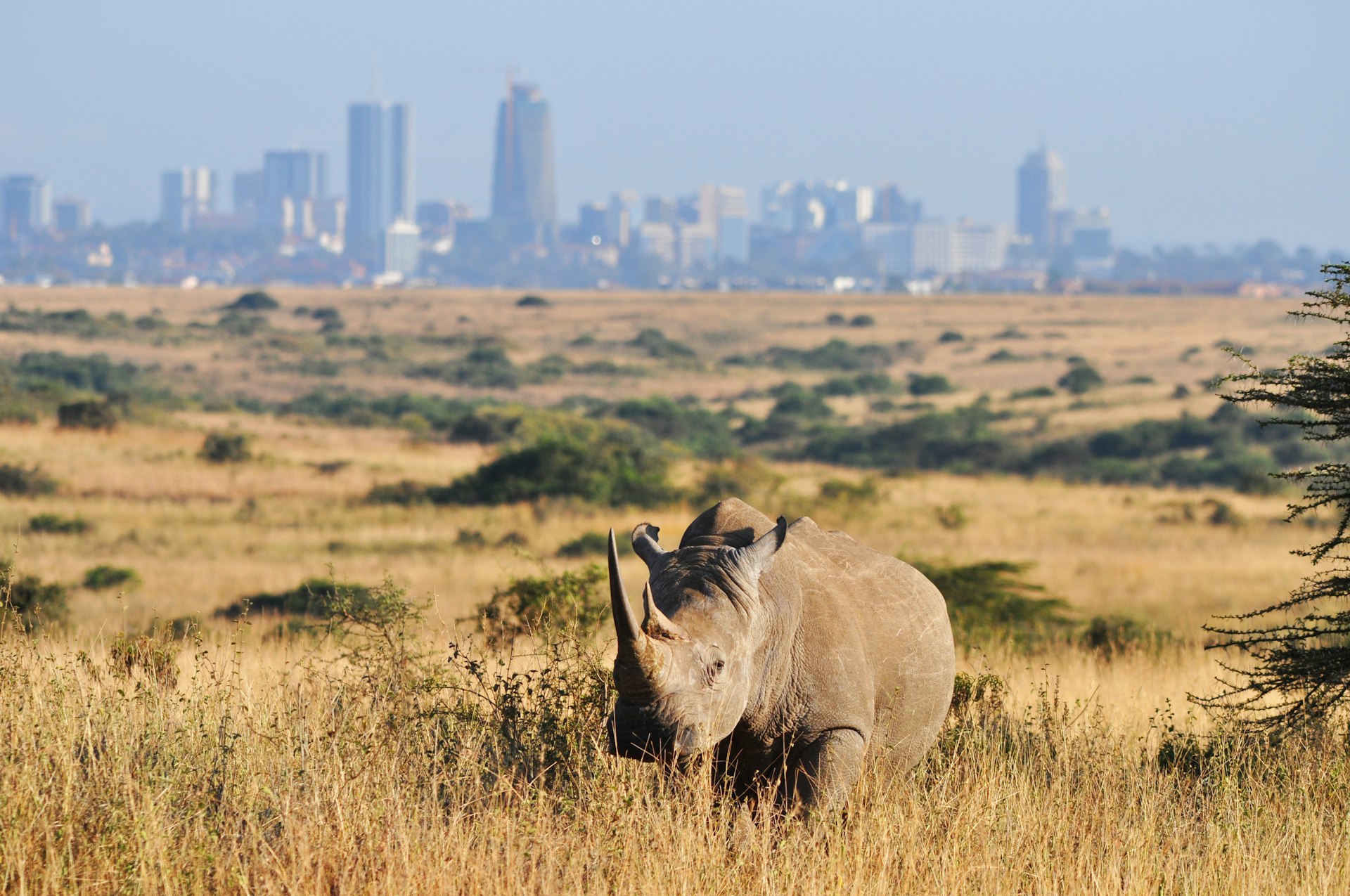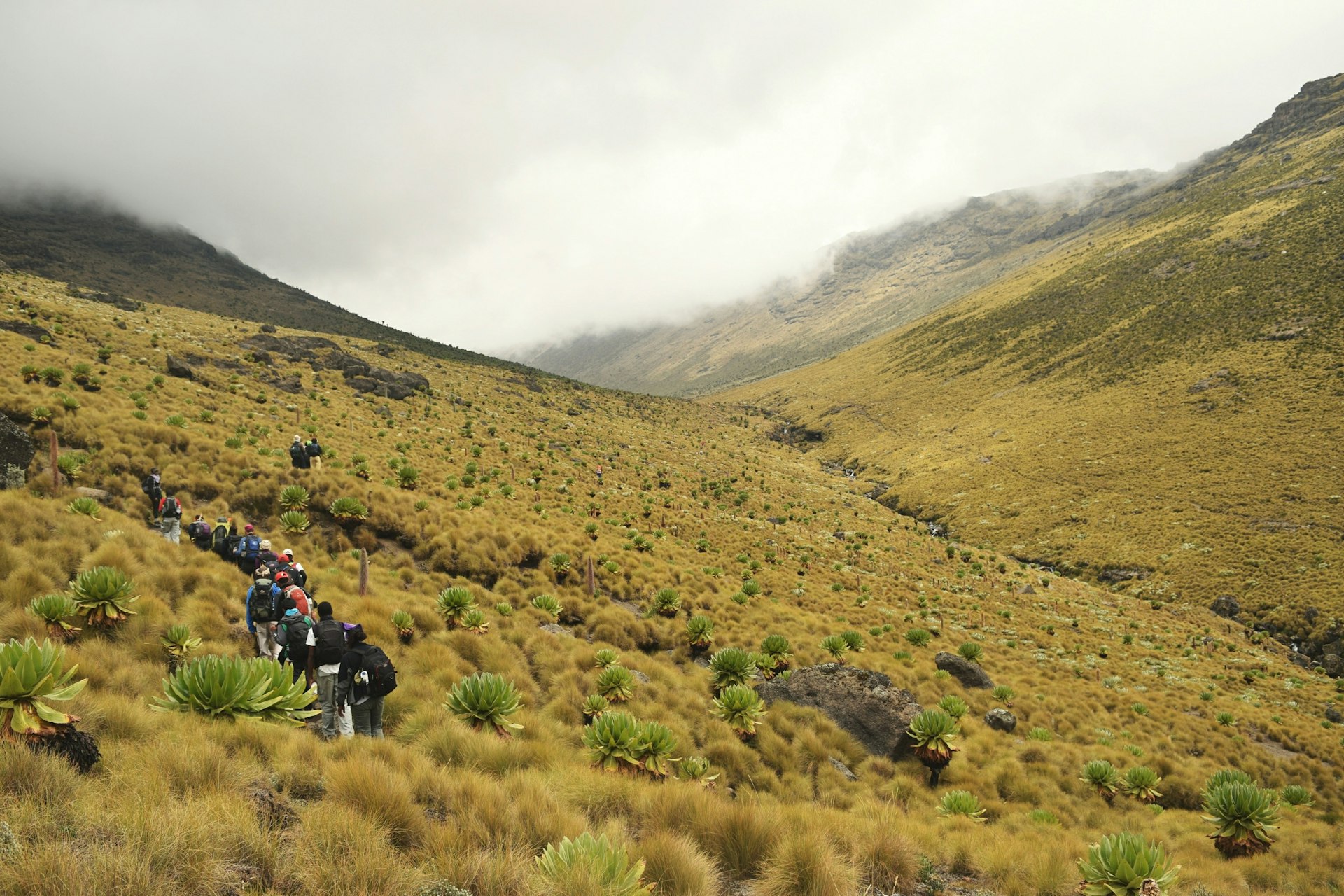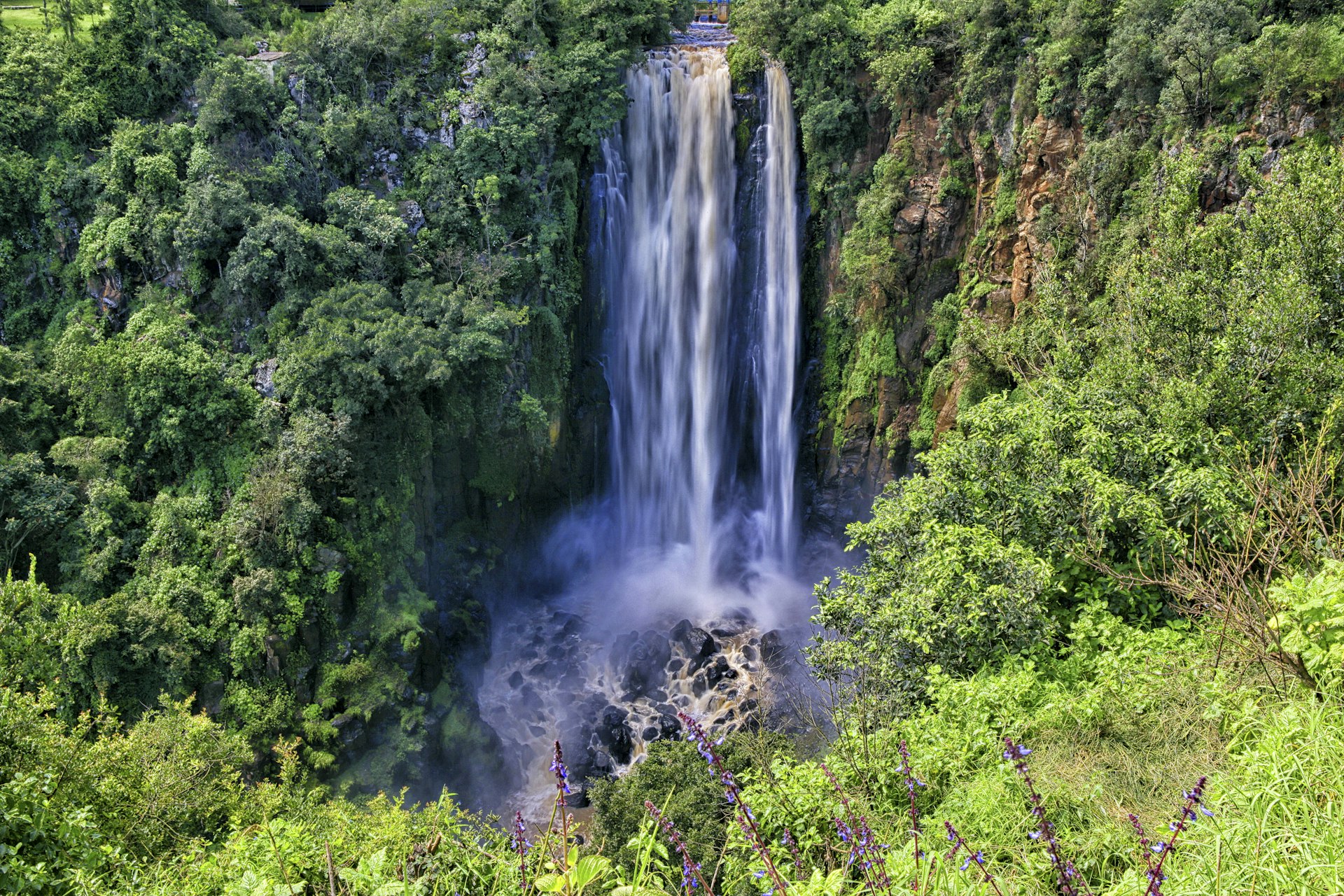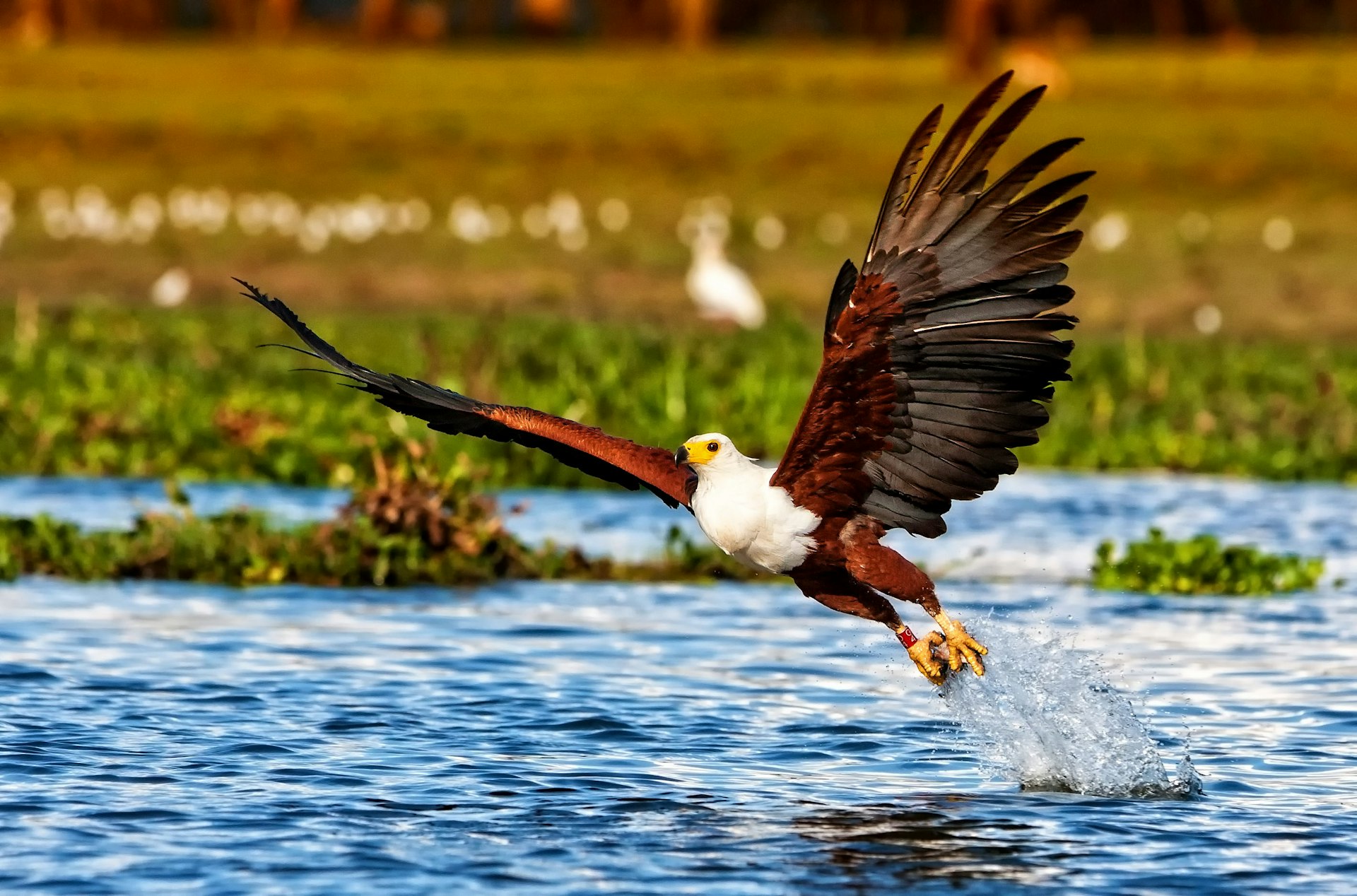National parks and Kenya go hand in hand. It’s home to a whopping 23 of them, as well as four marine national parks. From the unforgettable scene of thousands of wildebeest crossing the Mara River during their migration to the sight of steaming geysers at Hell’s Gate National Park, Kenya certainly has no shortage of protected parks, reserves, marine parks, and privately owned conservancies.
Many people go on safari in Kenya with a steely determination to see the Big Five (rhino, buffalo, elephants, leopards, and lions). The term originates from colonial-era hunters who deemed these to be the most dangerous animals to hunt on foot, so don’t let an obsession with seeing them all stop you from visiting national parks that don’t feature the full list – you’re sure to spot plenty of other equally fascinating creatures.
From spectacular scenery and geothermal springs to brilliantly colored birdlife and the indigenous communities that live in and around these areas, Kenya’s national parks are about more than wildlife, and you’ll be in for a treat whatever parks you choose to visit. These are the 12 best national parks in Kenya.

1. Masai Mara National Reserve
Known locally as the Mara, the Masai Mara National Reserve is Kenya’s most famous national park, not least because from July to October, it’s the route for the Great Migration, the spectacle of thousands of wildebeest, giraffes and zebra traveling from the Serengeti in southern Tanzania across the Mara River to the lush grass of Kenya. Nile crocodiles lie on the riverbanks waiting for their prey.
The semi-nomadic Maasai communities are another draw, with travelers attracted to their traditional singing and dancing, warrior traditions and colorful dress. The Maasai people own several private reserves around the Mara, which are leased to different safari companies, and these are one way to support community-powered tourism. A bush walk with a Maasai warrior is a wonderful way to appreciate the community’s connection with the land, as they point out wildlife and medicinal plants.
It’s not always easy to ensure cultural tourism experiences are genuinely ethical and non-exploitative. Ideally, visit a Maasai-run project, or ask your tour operator exactly where your money goes. If companies claim to support community projects, ask how and if you can see them. Conversely, some tourists report being overcharged (for crafts or a photo, for example), but this is often the consequence of years of communities seeing wealthy travelers pass through their villages on expensive tours that haven’t benefited them.
The Mara is a Big Five park, home to rhinos, buffalo, elephants, leopards and lions. The Mara has one of the world’s highest densities of lions, but the birdlife – 470 species, including birds of prey and migratory birds – and the wild savanna are just as alluring. To get a sense of the vastness of the Mara, book a hot-air balloon safari. You’ll see why the Maasai people named it the Mara (“spotted land”) as you float over specks of shrubs, cloud shadows, and animal herds. Walking and horseback safaris, in the company of armed rangers, are an incredible way to experience the beauty of the Mara up close.

2. Amboseli National Park
In southern Kenya near Tanzania, Amboseli National Park is known for its big-tusked (tusker) elephant herds – the population is estimated at 1500 – and its views of Mt Kilimanjaro. The relatively stable number of elephants is mostly thanks to the work of the Amboseli Trust for Elephants, one of the most celebrated such projects in the world. Amboseli doesn’t get as much rain as other parks but has a network of swamps instead – due to its mountain forest environment – which attracts a lot of birdlife. The park is also home to big cats, buffalo, Maasai giraffe, antelopes and vervet monkeys.
The word “Amboseli” comes from the Maasai for “salty dust,” and you’ll often see elephants caked in this dry, white mud after a good wallow. This region is also home to Maasai people. Some conservation areas such as Selenkay are Maasai-owned, and you can support the community by staying in and visiting their villages.
To photograph views of Kilimanjaro, aim for an early wake-up call when it’s clear and before the clouds come in. Weather patterns, environmental issues and climate change have also changed the movement of wildlife, so you might now see flamingos in Amboseli, when before they were more commonly sighted at Lake Naivasha or Lake Nakuru. Wildebeest, not usually a common sight in Amboseli, have also been spotted recently.
Outside of the rainy season, Lake Amboseli is dry, which can make for beautifully stark photography. For incredible views of the park, head to Observation Hill, where you can see the swamp being enjoyed by elephants, hippos, and more.

3. Tsavo National Park
Made up of two national parks, Tsavo East National Park and Tsavo West National Park, Tsavo in southwest Kenya is best known for its large elephant herds and impressive semi-arid landscape. Tsavo East is one of Kenya’s oldest parks and, combined with Tsavo West, comprises Kenya’s largest national park.
The parks were split when the railway line from Mombasa to Kenya’s interior was constructed, and now a highway also runs between Nairobi and Mombasa, making Tsavo a great safari stop-off on a city-to-coast vacation.
The two parks have slightly different terrains. Tsavo East is mostly flat plains, with the Galana River flowing through. Camping along the river is one of the highlights of Tsavo, as is taking a walking safari across the vast Yatta Plateau, the world’s longest lava flow at 300km (186 miles).
Tsavo West, home to Lake Jipe and Mzima Springs, is wetter, more mountainous and swampier. Bird spotting is better in Tsavo West, which has around 500 species. Most impressive of all is the force of Mzima Springs, where 50 million gallons of water rush out from the lava rock. The lushness makes for prolific game-viewing, with elephants, hippos, crocodiles, zebras, giraffes and monkeys hydrating and hanging out in this verdant terrain. For epic views, it’s hard to beat the scene over the plains from Poacher’s Lookout.

4. Nairobi National Park
Opened in 1946, Nairobi National Park was Kenya’s first national park and is the world’s only national park within a city. Some travelers even manage to get in a few wildlife sightings on their way to or from the airport.
It’s deeply surreal to be on an open plain with Nairobi’s skyscrapers as a backdrop, and among the acacia bush, you’ll spot a variety of game, including lions, leopards, buffalo and the endangered black rhino. The park has developed a successful rhino conservation program and restocked other parks through their breeding projects. As in many national parks across Kenya, the birdlife is excellent, with more than 400 species recorded here.
The park has designated picnic spots, walking trails around the hippo pools and campsites, so it’s a viable choice for a day trip or overnight if you don’t have time to travel farther. Also inside the park is the Sheldrick Wildlife Trust, a rhino and elephant sanctuary that retains links with Tsavo National Park, where David Sheldrick worked as an anti-poaching warden. Visitors to the sanctuary can see the Trust’s rescue and rehabilitation program in practice and watch the animals at feeding time, from a distance.

5. Mt Kenya National Park
If you’re a hiker or a climber, Kenya’s second highest mountain, Mt Kenya, deserves a spot near the top of your best treks list for the trail to Point Lenana, the main peak for trekkers. Mt Kenya National Park has great camping, including wild camping along some of the lesser-used trails, and rock climbing on the lower peaks. The park also features a 10km (6.2-mile) hike up to the Met Station if you only have time for a day excursion.
This Unesco-listed park is pure joy to explore, with its ecosystem of lakes, glaciers, mineral springs and Afro-Alpine forest. You’re in for sweeping views of high ridges, deep valleys and dense forest gradually meeting glacial terrain as you go higher into the park.
Mt Kenya is home to elephant, mongoose, bushbuck, eland and colobus monkeys, but it’s the walking trails and scenery that are its biggest attraction. Mt Kenya lies within the Laikipia Plateau, a network of conservancies mostly managed by local communities, so it’s an excellent region for community-based tourism accommodation. The three-day drive from Nairobi to Mt Kenya National Park is also one of Kenya’s best road trips.

6. Aberdare National Park
Aberdare National Park is perhaps the most distinctive of all Kenya’s national parks, a place to savor nature in the cooler climes of the central highlands. While you will see wildlife, Aberdare is known primarily for the outstanding natural beauty of its misty forests and river valleys. The High Park, as the higher moorlands are sometimes called, is perfect for hiking. You can climb the peaks of Lesatima, Il Kinangop and Kipipiri easily, but you’ll need a guide and a pass, so arrange your excursion in advance.
Created in 1950 to protect the Aberdare mountains, which drop to the Rift Valley on the western side, the park comprises dense forest, steep ravines, open moorland and thundering waterfalls. It is home to black rhinos, elephants, baboons, colobus monkeys, buffalo and elusive leopard. Birdwatchers are also in for a treat, with more than 250 species sighted.
The park also has a lot of history. In the 1950s, the dense forest hid Kenya’s Kikuyu Mau Mau guerrillas during their struggle against European colonization. And it is home to Treetops Lodge, where Princess Elizabeth found out she would be Queen of the United Kingdom in 1952 after the early death of her father. You need a good 4WD vehicle if you’re heading to Aberdare, especially when it’s rainy.

7. Meru and Kora national parks
If you’re looking for rugged, remote and pristine landscapes, Meru and Kora national parks in the Rift Valley are great options. These parks contain vast grasslands, thorny bush, gushing rivers and thick jungle, and you’ll find Grevy’s zebras, elephants, buffalo, hippos and giraffes – plus more than 420 bird species.
The landscape, with huge swathes of savanna, dries out in the dry season, so staying cool and hydrated is important. A good eight-hour drive from Nairobi, Meru and Kora are some of the more off-the-beaten-track national parks.

8. Samburu National Reserve
Samburu National Reserve, north of Laikipia, is a popular park on the northern safari circuit. It’s home to the “Special 5” – Grevy’s zebra, Somali (blue-necked) ostrich, reticulated giraffe, gerenuk and beisa oryx (both types of antelope) – so-called because they’re not typically found in Kenya’s southern game reserves. The Samburu and Rendille people of this region are involved in protecting and monitoring Grevy’s zebras.
Named after the Samburu people, nomadic pastoralists, and a warrior people for whom this region is home, this national park is one of the best places to see leopards in Kenya, and it’s a prime spot for tuskers. You can also experience Samburu culture and go on camel-trekking safaris with Samburu guides.
Drought is an issue in Samburu. Far drier than the Mara, the Ewaso Nyiro River is a lifeline for the pastoral communities, wildlife and flora and fauna. When wildlife gathers on the river banks, it’s quite a sight, and a photographer’s dream. Samburu is one of the parks where George and Joy Adamson of Born Free-fame raised Elsa the lioness.

9. Hell’s Gate National Park
A unique element of the Great Rift Valley is the dramatic landscape of Hell’s Gate National Park, one of the most atmospheric of Kenya’s national parks. Geothermal steam rises from the ground in an epic landscape of volcanoes, basalt columns, high cliffs and gorges. From a huge natural spa pool managed by KenGen (Kenya’s main electric power producer), you can enjoy the views over a hot soak.
While wildlife isn’t the prime reason for visiting Hell’s Gate, the park counts zebras, buffalos, antelopes, and baboons among its residents. Its 100 recorded bird species include vultures and Verreaux’s eagles. You’ll also sometimes spot raptors that have set up their nests in the cliffs. The park is particularly popular with walkers, mountain bikers, rock climbers, and cyclists. If you’re a Lion King fan, you’ll be impressed that the rock formation at Hell’s Gate Gorge is what inspired Pride Rock.
Hell’s Gate National Park is a doable day trip from Nairobi, often combined with Lake Nakuru or smaller soda (alkaline) Lake Elmenteita, which has a population of flamingos.

10. Lake Nakuru National Park
Within driving distance of Nairobi, Unesco-listed Lake Nakuru on the floor of the Great Rift Valley allows you to pack a game drive, birdwatching, a hike and a picnic into one day.
With around 450 bird species recorded, Lake Nakuru National Park is a particularly good place for spotting water birds because of high algae levels, although flamingo numbers have been dropping as issues around pollution and human encroachment have affected the lake. It still attracts many pelicans and other water birds. You’ll also see animals such as waterbuck and white rhinos. The park is known for its annual 50km (31 miles) Cycle With the Rhinos race, which raises funds for the endangered rhino.
The lake is surrounded by high ridges: head to the viewpoints of Lion Hill, Baboon Cliffs and the Out of Africa Lookpoint for some of the best vistas over the lake and valley. Many travelers combine this national park with a visit to the Menengai Crater, the caldera just outside Nakuru town, which has incredible views over the landscape. The crater is the site of a Mau Mau Cave, where guerrilla soldiers camped out during the 1950s Mau Mau uprising in resistance to British colonial rule.

11. Lake Naivasha
Though not technically a national park, with its deep blue freshwater lake and nearby patchwork of waterfalls, gorges, acacia forests and extinct volcanoes, Lake Naivasha is one of the prettiest and most accessible areas near Nairobi. Hippos are at home in the high-altitude lake, which often has pelicans and other water birds nearby. On the banks, you’ll see small herds of zebra, buffalo and several species of antelope. It’s a top destination for birding, especially birds of prey.
The naturalist Joy Adamson lived on the shores of Lake Naivasha with her husband George, where together they raised the lion cub Elsa. The story became an award-winning book and film, Born Free. Their former home, Elsamere, is now a museum and conservation and field study center.

12. Lake Turkana National Parks
Three parks – Sibiloi National Park, the South Island and Central Island National Parks – make up the Unesco-listed Lake Turkana National Parks, surrounding the vivid greenish-blue Lake Turkana, the world’s largest permanent desert lake. This otherworldy region is ideal for the adventurous traveler: it’s hot, dry, windy, vast and volcanic.
Central Island consists of three active volcanoes and three crater lakes, where you’ll find the largest concentration of Nile crocodiles in the world, plus enormous Nile perch and tilapia fish. You should see a decent amount of game – such as zebras, hyenas, kudu – and if you’re lucky, lions, cheetahs and leopards. Volcanic ash covers South Island, which has become a breeding ground for more than 20 bird species and a large crocodile population.
Lake Turkana hosts one of Kenya’s biggest cultural festivals. The three-day Lake Turkana Festival in Loyangalani on the southeastern coast of the lake celebrates the heritage of the communities that live here, who fish in the Lake Turkana basin, and whose languages and cultures require the same preservation as the environment.


Fantastic perspective! The points you made are thought-provoking. For more information, I found this resource useful: FIND OUT MORE. What do others think about this?
I don’t think the title of your article matches the content lol. Just kidding, mainly because I had some doubts after reading the article.
I don’t think the title of your article matches the content lol. Just kidding, mainly because I had some doubts after reading the article.
I don’t think the title of your article matches the content lol. Just kidding, mainly because I had some doubts after reading the article.
Your article helped me a lot, is there any more related content? Thanks!
You’ve done an impressive work on your website in covering the topic. I am working on content about Entrepreneurs and thought you might like to check out FQ4 and let me what you think.
Thank you for your sharing. I am worried that I lack creative ideas. It is your article that makes me full of hope. Thank you. But, I have a question, can you help me? https://accounts.binance.com/register?ref=P9L9FQKY
Can you be more specific about the content of your article? After reading it, I still have some doubts. Hope you can help me.
Thank you for your sharing. I am worried that I lack creative ideas. It is your article that makes me full of hope. Thank you. But, I have a question, can you help me?
I don’t think the title of your article matches the content lol. Just kidding, mainly because I had some doubts after reading the article.
Thank you for your sharing. I am worried that I lack creative ideas. It is your article that makes me full of hope. Thank you. But, I have a question, can you help me?
Your article helped me a lot, is there any more related content? Thanks!
I don’t think the title of your article matches the content lol. Just kidding, mainly because I had some doubts after reading the article.
Thank you for your sharing. I am worried that I lack creative ideas. It is your article that makes me full of hope. Thank you. But, I have a question, can you help me?
canadianpharmacy com
https://expresscanadapharm.com/# Express Canada Pharm
pharmacy in canada
Thanks for sharing. I read many of your blog posts, cool, your blog is very good.
Your point of view caught my eye and was very interesting. Thanks. I have a question for you.